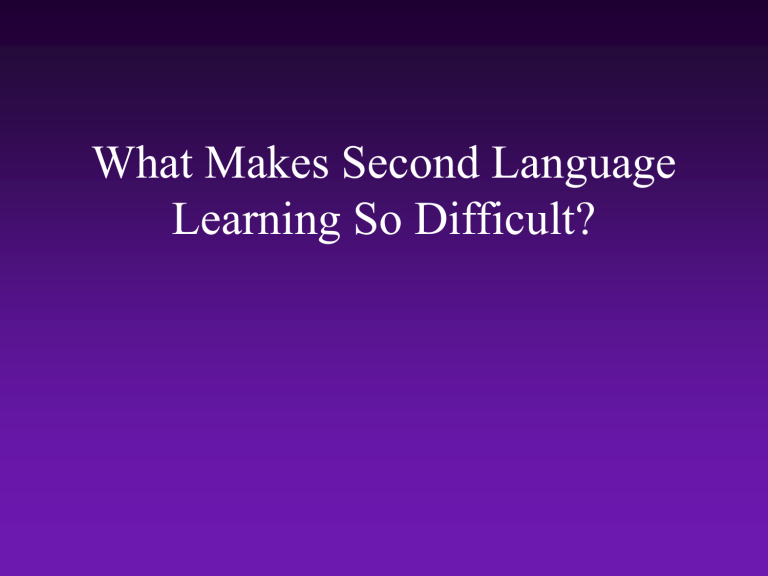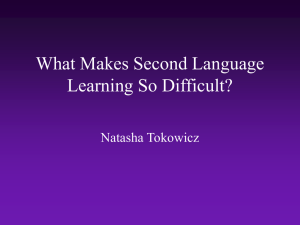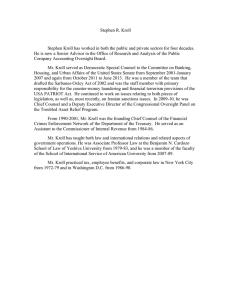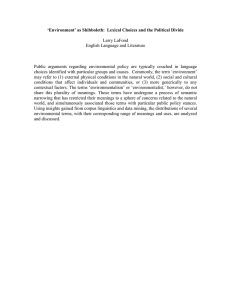What Makes Second Language Learning So Difficult
advertisement

What Makes Second Language Learning So Difficult? Difficulties in Adult Second Language Learning • A lot of information to learn • Embarrassment at speaking language Differences between the new language and your native language (e.g., The Competition Model, MacWhinney & Bates, 1989) So, Why Learn Another Language? So, Why Learn Another Language? QuickTime™ and a decompressor are needed to see this picture. So, Why Learn Another Language? • Communicate with people of different language backgrounds – Especially an important message! • Identify with another group • Learn about another culture • Learn more about your own language What factors make adult second language learning difficult? • Exp. 1: Meaning differences across languages – Multiple translations-more than one way to say something • Exp. 2: Syntactic differences across languages – Grammatical constructions that differ • Experiment in progress – ERP techniques Current Knowledge Both Helps and Hurts • Adult second language learners: – – – – Full set of concepts Full set of labels for these concepts Full grammatical system Full system for contrasting sounds • Sometimes these will transfer appropriately – E.g., same or similar labels (cognates): e.g., color-color Mismatches between languages create problems Connecting Meanings to Labels • Initially, concepts are strongly connected to L1 words • Eventually concepts must get connected to L2 words for comprehension or production Two Labels for the Same Meaning? • Most models assume the concepts activated by the two languages are the same – Exception: Distributed Feature Model • Word concreteness – cat – health • Cognate status of translation pair – color-color – house-casa Conceptual Salience High conceptual salience Low conceptual salience Distributed Feature Model De Groot (1992) L1 Concrete Words Cognate Translations L2 lexical (word) level conceptual (meaning) level L1 Abstract Words Noncognate Translations L2 lexical (word) level conceptual (meaning) level L1: First Language L2: Second Language Why Else Meanings May Differ • Different lexical concepts – “sibling” in Dutch = broers en zussen (brothers and sisters) • Culturally-specific concepts – “gezellig” in Dutch = ??? • Culturally-distinct meanings – “sombrero”, “iglesia” Broadness of application of terms in the two languages--semantic boundaries Prepositions (Ijaz, 1986) Semantic boundaries differ across languages – German learners of English under-emphasize contact and over-emphasize movement for “on” • close translation equivalent of “on” in German is “auf”, which can denote a motional meaning like the English word “up” • Result is multiple translations, which are problematic for the L2 learner Sources of Multiple Translations • Imprecise correspondence across languages • Synonymy – sofá sofa or couch • Ambiguity within a language – glass vidrio or vaso in Spanish – to be ser or estar in Spanish Ambiguity at Its Worst: “Trunk” “romp” “achterbak” or “kofferbak” “stam” or “boomstronk” “slurf” Experiment 1 • What happens when meanings differ? • Different consequences depending on type of multiple translations – synonyms – multiple meanings • Translation Task + cat “gato” Method of Experiment 1 • Participants: adult L2 learners – 24 Dutch-English Speakers • Translated words aloud in both directions – L1 to L2 – L2 to L1 • Recorded responses – Accuracy – Reaction time for correct responses Design • Manipulated – Number and type of translations • Number of meanings • Number of forms for meaning selected – “Conceptual salience” (CS) • A composite measure of concreteness and context availability Stimuli • Number of translations norms – Number of translations – Number of meanings translated • E.g., if said “slurf”, translated snout meaning • Semantic similarity ratings – How similar in meaning are these words? • All pairs were considered translation equivalents • Form similarity ratings – How similar are these words in spelling/sound? • All pairs were considered translation equivalents Predictions for Experiment 1 • High conceptual salience words faster than low conceptual salience words • Multiple forms slower than one form – Need to select one to say (e.g., vaso, vidrio) • Multiple meanings slower than one meaning – Need to select one to translate (e.g., trunk) Data Analysis of Experiment 1 • Hierarchical regression analysis • Covaried effects of word length and frequency • Directionality taken into account – Data collapsed across direction Results of Experiment 1 1200 One M eani ng, One Form for M eani ng Sel ected T wo M eani ngs, One Form for M eaning Selected One M eani ng, T wo Form s for M eaning Selected 1100 1000 900 800 Low High Conceptual Salience • Unambiguous words show CS effect • Cost for multiple forms similar for high and low CS words • Cost for multiple meanings only for high CS words Accuracy Data: Experiment 1 100 One Meaning, One Form for Meaning Selected 90 Two Meanings, One Form for Meaning Selected One Meaning, Two Forms for Meaning Selected Estimated Accuracy (%) 80 70 60 50 40 30 20 10 0 Low High Conceptual Salience • Unambiguous words show CS effect • High CS words with multiple meanings lower in accuracy Tokowicz & Kroll Model of Language Production • Adapted from Poulisse & Bongaerts (1994) • Stages of language production • Sources of competition Tokowicz & Kroll Model Meaning Level door strawberry raspberry strawberry deur aardbei framboos “aardbei” Word Level Tokowicz & Kroll Model Meaning Level door strawberry raspberry strawberry deur aardbei framboos “aardbei” Word Level Tokowicz & Kroll Model Meaning Level door strawberry raspberry strawberry deur aardbei framboos “aardbei” Word Level Tokowicz & Kroll Model Meaning Level door strawberry raspberry strawberry deur aardbei framboos “aardbei” Word Level Tokowicz & Kroll Model Meaning Level door strawberry raspberry strawberry deur aardbei framboos “aardbei” Word Level Tokowicz & Kroll Model Meaning Level door strawberry raspberry strawberry deur aardbei framboos “aardbei” Word Level Tokowicz & Kroll Model Multiple Forms Meaning Level door throat throat mouth deur strot “strot” keel Word Level Tokowicz & Kroll Model Multiple Forms Meaning Level door throat throat mouth deur strot “strot” keel Word Level Tokowicz & Kroll Model Multiple Forms Meaning Level door throat throat mouth deur strot “strot” keel Word Level Tokowicz & Kroll Model Multiple Forms Meaning Level door throat throat mouth deur strot “strot” keel Word Level Tokowicz & Kroll Model Multiple Forms Meaning Level competition door throat throat mouth deur strot “strot” keel Word Level Tokowicz & Kroll Model Multiple Forms Meaning Level door throat throat mouth deur strot “strot” keel Word Level Tokowicz & Kroll Model Multiple Meanings Meaning Level door calf thigh calf cow calf deur dij kuit koe “kuit” Word Level Tokowicz & Kroll Model Multiple Meanings Meaning Level door calf thigh calf cow calf deur dij kuit koe “kuit” Word Level Tokowicz & Kroll Model Multiple Meanings Meaning Level door calf thigh calf cow calf deur dij kuit koe “kuit” Word Level Tokowicz & Kroll Model Multiple Meanings Meaning Level competition door calf thigh calf cow calf deur dij kuit koe “kuit” Word Level Tokowicz & Kroll Model Multiple Meanings Meaning Level door calf thigh calf cow calf deur dij kuit koe “kuit” Word Level Tokowicz & Kroll Model Multiple Meanings Meaning Level door calf thigh calf cow calf deur dij kuit koe “kuit” Word Level Interim Summary • Multiple forms create competition • Multiple meanings create competition if simultaneously active • Conceptual salience interacts with type of multiple translations Extensions • Add sentence or paragraph context – Reduce or eliminate conceptual salience effect – Reduce meaning effect – Not reduce form effect • Developmental change – Less proficient learners will show less competition Competition at Other Levels of Language Production • Start out like L1 and shift to L2 – Like prepositions (e.g., McDonald, 1987) • Does the L1 really interfere with L2 grammatical processing? Experiment 2: Grammaticality Judgment • What happens when the two languages are in direct conflict? • 14 Native English speakers learning Spanish as a second language • Read grammatical and ungrammatical sentences in Spanish • Push button responses regarding grammaticality Grammatically Acceptable Stimuli • Correct in Spanish (not English) – Se lavó el coche. *Was washed the car. • Correct in both languages – El coche fue lavado. The car was washed. Grammatically Unacceptable Stimuli • Correct in English (not Spanish) – *El coche estuvo lavado. The car was washed. • Correct in neither language – *El coche lavado. *The car washed. Predictions-Experiment 2 • If L1 grammar interferes with L2 grammar: – “yes” responses Should see difference between “both” and “Spanish” conditions – “no” responses Should see difference between “neither” and “English” conditions Should be difficult to reject English sentences Reaction Time Data-Experiment 2 • RT corrected for length of sentences • More difficult to reject English sentences • No difference between Spanish and Both Accuracy Data-Experiment 2 • Accuracy corrected for length • More accurate at rejecting English sentences • False alarms in Neither condition Conclusions • Stimuli in “both” condition less familiar?, or • Accuracy in L1 leads learners to question acceptability in “Both” condition? • Good at English only, but slow Strategic effects? Event-Related Brain Potentials • Temporally sensitive measure of on-line processing • Derived from the electroencephalographic (EEG) record • Reflect synchronous depolarization of populations of neurons ERP Setup • Electrodes are placed painlessly on the surface of the scalp • These electrodes record brain activity – Background activity – Stimulus-locked activity ERP Components • Grammatical violations elicit a “P600” response – A positive-going deflection in voltage that occurs between approximately 500 and 700 ms post stimulus Legend: Osterhout & Nicol (1999) ERP Components • Semantic violations elicit a “N400” response – A negative-going deflection in voltage that occurs between approximately 300 and 500 ms post stimulus Legend: Osterhout & Nicol (1999) Grammaticality Judgment-ERP • Native English speakers learning Spanish as a second language • Read grammatical and ungrammatical sentences in English and Spanish – Separate blocks for English and Spanish • Push button responses regarding grammaticality The old blender doesn’t crushing ice cubes. ? Predictions • Ungrammatical sentences will elicit a P600 response compared to grammatical sentences – Significantly more positive amplitude between 500 and 700 ms post-stimulus Acceptability in English P600 Acceptable Unacceptable N400 The old blender doesn’t crushing ice cubes. Acceptability in Spanish P600? Acceptable Unacceptable N400 Él trabajando cada día. Summary • Why is second language learning so difficult? – Differences between the two languages • Multiple levels – Multiple forms – Multiple meanings – Different grammatical constructions Future Directions • On-line examination of semantic differences – E.g., The pizza was too hot to eat/*drink. • Are the effects similar for different language pairs that have more/fewer differences? • Are there competition effects in phonology? • Would context reduce the competition observed in Experiment 1? Acknowledgments • • • • • • Brian MacWhinney Judith Kroll NIH NSF Sigma Xi Penn State RGSO



